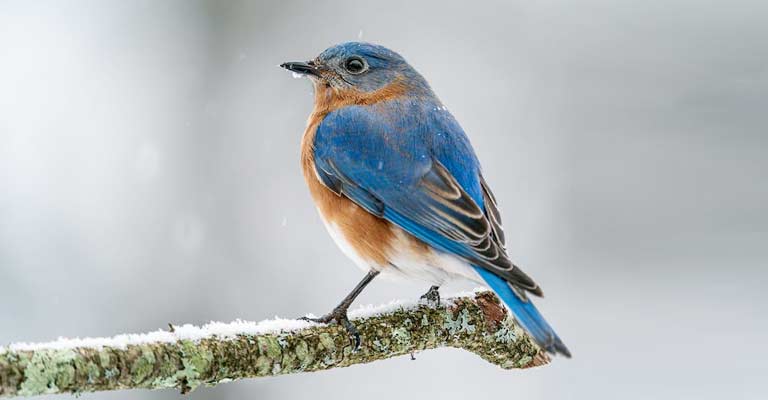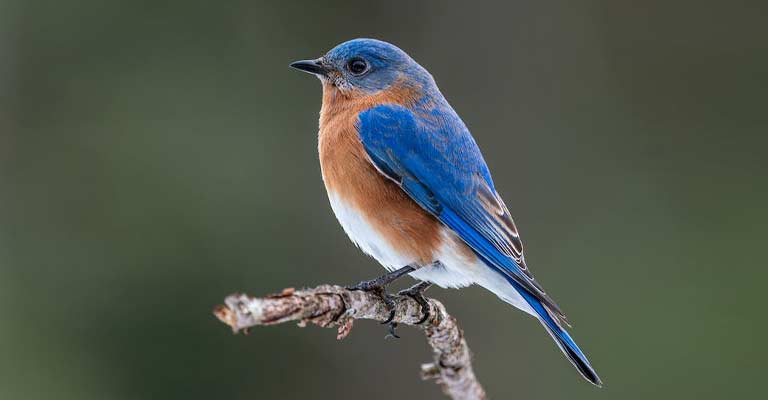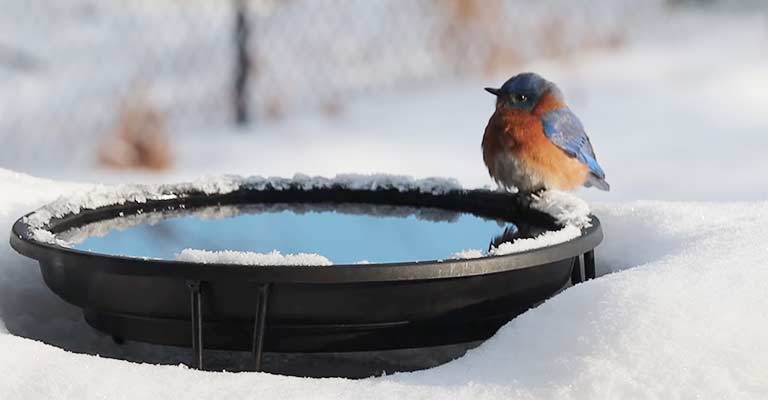As winter blankets the landscape in a serene hush, the vibrant blue plumage of bluebirds stands out against the snowy canvas. Delving into the intricate tapestry of nature, this exploration unravels the bluebird winter habits.
From their resilient foraging techniques to the fascinating social dynamics within their winter flocks, these azure-winged wonders navigate the chilly season with remarkable adaptability.
Join us on a journey through the frost-kissed realms where Bluebirds thrive, unraveling the secrets behind their survival strategies and uncovering the subtle nuances that make winter a unique chapter in their avian existence.
Discover how these charismatic creatures cope with the challenges of colder climates and witness the beauty that unfolds when blue meets snow, encapsulating the essence of Bluebird Winter Habits.
Let’s delve into the enigmatic habits of bluebirds. Explore their resilient foraging, fascinating social dynamics, and adaptive survival strategies.

Bluebird Winter Habits You Need to Know About
Bluebirds known for their vibrant plumage and melodious songs, face unique challenges as winter blankets the environment in a serene hush.
Let’s delve into the intricate tapestry of bluebird behavior during the colder months, exploring their foraging techniques, social dynamics, and the fascinating strategies that enable them to thrive in frost-kissed realms.
Foraging Resilience
Bluebirds are no strangers to the challenges posed by winter’s chill. As temperatures drop and food becomes scarcer, their foraging habits transform.
Unlike some migratory birds that venture south, bluebirds often remain in their territories, relying on their adaptability to navigate the harsh conditions.
Bluebirds showcase remarkable resilience in finding food sources during winter. Their diet shifts to include more berries, fruits, and insects that may still be available.
The ability to adapt their foraging techniques ensures a continued food supply, allowing these avian inhabitants to endure the scarcity that winter brings.
Social Dynamics in Winter Flocks
Winter for bluebirds is not just about individual survival; it’s also a time for communal living. Bluebirds exhibit fascinating social dynamics during this season, forming winter flocks that provide additional support and protection.
These winter flocks serve multiple purposes. First and foremost, they create a collective effort to find food. Bluebirds share information about feeding locations, enabling the group to cover a larger area more efficiently.
This collaborative foraging strategy helps compensate for the reduced availability of resources in winter.
Beyond practical considerations, winter flocks contribute to the social well-being of bluebirds. The sense of community provides warmth, both physically and metaphorically.
It fosters a supportive environment, enhancing their chances of survival in the face of winter’s challenges.
Adaptive Survival Strategies
Surviving winter requires not only resilience but also strategic adaptations. Bluebirds employ several clever strategies to navigate the colder months successfully.
One such strategy is communal roosting. Bluebirds gather in communal roosts during the night, huddling together to conserve warmth.
This collective approach helps them maintain body heat, reducing the energy expenditure required to stay warm during chilly nights.
Choosing suitable roosting locations is another crucial aspect of their winter survival. Bluebirds seek out sheltered spots, such as dense evergreen foliage or tree cavities, to protect themselves from harsh winds and precipitation.
These chosen roosting sites contribute to the overall well-being of the flock.
The Beauty of Blue Meets Snow
As winter envelopes the landscape in a pristine blanket of snow, the vibrant blue plumage of bluebirds creates a stunning contrast.
The sight of these azure-winged wonders against the white backdrop is a testament to the beauty that unfolds when nature’s elements converge.
Bluebirds bring a touch of vibrancy to the winter tableau, adding a splash of color to an otherwise monochromatic scene. Observing them flit among snow-covered branches is a visual symphony that resonates with the inherent poetry of the natural world.
A Profound Appreciation
In witnessing the winter habits of bluebirds, there arises a profound appreciation for the intricate tapestry of life. These avian inhabitants embody the spirit of adaptability, demonstrating that even in the coldest seasons, life persists with unwavering determination.
The delicate balance struck between vulnerability and resilience in the bluebirds’ winter tale mirrors the broader narrative of nature’s enduring cycles. It serves as a reminder that, despite the challenges, life finds a way to persist and flourish.
The azure wings of bluebirds become ambassadors of beauty and adaptation, leaving an indelible mark on the snowy landscapes they grace.
Do Bluebirds Migrate in the Winter?

As winter blankets the landscape, the question arises: do bluebirds migrate to warmer regions, or do they brave the cold in their familiar territories?
The answer unveils a fascinating aspect of bluebird behavior, encompassing both migratory patterns and the unique strategies they employ to endure winter’s chill.
Migratory Instincts vs. Resident Strategies
Bluebirds, comprising Eastern, Western, and Mountain Bluebirds, display a spectrum of migratory behaviors. While some individuals within these species migrate south during winter, others adopt a resident strategy, staying put in their territories.
Eastern Bluebirds
In the northern regions of their range, Eastern Bluebirds exhibit migratory tendencies. As temperatures drop and food becomes scarcer, some individuals migrate to warmer southern regions in search of more favorable conditions.
Conversely, Eastern Bluebirds in milder climates, such as parts of the southeastern United States, may choose to stay in their territories throughout the winter.
Western and Mountain Bluebirds
Western and Mountain Bluebirds often display migratory patterns, especially in the northern parts of their ranges. As winter approaches, these bluebirds may embark on journeys to warmer locales.
In areas with more temperate climates, some Western and Mountain Bluebirds opt for a resident strategy, braving the winter months in their familiar habitats.
Factors Influencing Migration
Several factors influence whether a bluebird population migrates or remains resident during winter.
Temperature and Food Availability
Bluebirds in colder regions are more likely to migrate as temperatures drop, and natural food sources become scarce. Migratory instincts kick in to seek more hospitable environments.
In areas with milder winters where food resources remain accessible, bluebirds may choose to stay resident, avoiding the energy-intensive migration.
Territorial Familiarity
Bluebirds that have established territories with reliable food sources might be more inclined to stay resident, benefiting from their knowledge of local resources.
Migratory Routes and Patterns
For those bluebirds that do migrate, understanding their routes and patterns adds another layer to the narrative of their winter journeys.
Eastern Bluebirds
Eastern Bluebirds migrating from northern regions often head south towards warmer climates. Some may travel significant distances, while others find suitable habitats closer to their breeding grounds.
Western and Mountain Bluebirds
Western and Mountain Bluebirds in northern ranges undertake southward migrations. They may join mixed-species flocks, enhancing their chances of survival during the journey.
Resident Strategies: How Bluebirds Brave Winter

For bluebirds opting for a resident strategy, winter survival involves adapting to the challenges posed by colder temperatures.
Adaptive Foraging
Bluebirds adjust their foraging habits during winter. While insects are a primary food source in warmer months, they shift to consuming more berries and fruits that persist through the colder season.
Communal Roosting
Resident bluebirds engage in communal roosting during chilly nights. Huddling together provides collective warmth, reducing energy expenditure and enhancing their ability to endure colder temperatures.
Strategic Roosting Sites
Bluebirds carefully select roosting sites, often choosing sheltered spots like dense evergreen foliage or tree cavities. These locations provide protection from harsh winter winds and precipitation.
Observing Bluebirds in Winter
For bird enthusiasts and casual observers alike, winter provides a unique opportunity to witness bluebirds in a different light.
Winter Beauty
The sight of bluebirds against a backdrop of snow-covered landscapes creates a visually stunning scene. Their vibrant plumage stands out, adding a touch of color to the winter tableau.
Behavioral Changes
Observing bluebirds during winter allows for a closer look at their adaptive behaviors. From foraging techniques to communal roosting, each aspect provides insights into their strategies for thriving in colder climates.
The winter habits of bluebirds showcase a dynamic interplay between migratory instincts and resident strategies.
Whether embarking on long journeys to warmer regions or braving the cold in familiar territories, bluebirds exemplify adaptability in the face of seasonal challenges.
As temperatures drop and snow blankets the landscape, the presence of bluebirds becomes a testament to the resilience and beauty of the natural world, inviting observers to appreciate the intricacies of avian life during the winter months.
FAQs
Do bluebirds migrate during winter?
Bluebirds exhibit varied behaviors; some migrate to warmer regions, while others stay resident. Factors like temperature and food availability influence their decision.
What do bluebirds eat in winter?
In winter, bluebirds adapt their diet, shifting from insects to berries and fruits. This strategic change ensures a continued food supply during colder months.
How do bluebirds survive the cold?
Bluebirds employ survival strategies, including communal roosting for warmth, adaptive foraging techniques, and selecting sheltered roosting sites to endure winter’s chill.
Where do bluebirds go in winter?
Bluebirds that migrate head south towards warmer climates. Specific routes vary by species, and some may travel significant distances, while others find suitable habitats closer to their breeding grounds.
Can I attract bluebirds to my yard in winter?
Yes, providing food sources like berries, mean worms, and installing roosting boxes can attract bluebirds during winter. Creating a hospitable environment encourages their presence.
Conclusion
The winter habits of bluebirds paint a captivating portrait of nature’s resilience. As the chill persists, these azure-hued avians showcase remarkable adaptability, weaving intricate social bonds within frost-kissed flocks.
Their tenacity in foraging against the winter’s grasp highlights a harmonious dance with adversity. Observing the subtle nuances of their survival strategies, one can’t help but be entranced by the delicate balance struck between vulnerability and resilience.
The bluebirds’ winter tale, told against the backdrop of snow-laden branches, echoes the larger narrative of nature’s enduring cycles.
As we witness these winged wonders navigate the frosty realms, we gain a deeper appreciation for the intricate tapestry of life, where each flutter of azure wings contributes to the timeless rhythm of the natural world.
In this frozen landscape, the bluebirds stand as ambassadors of beauty and adaptation, leaving us with a profound admiration for the wonders that unfold when winter embraces the winged inhabitants of our world.